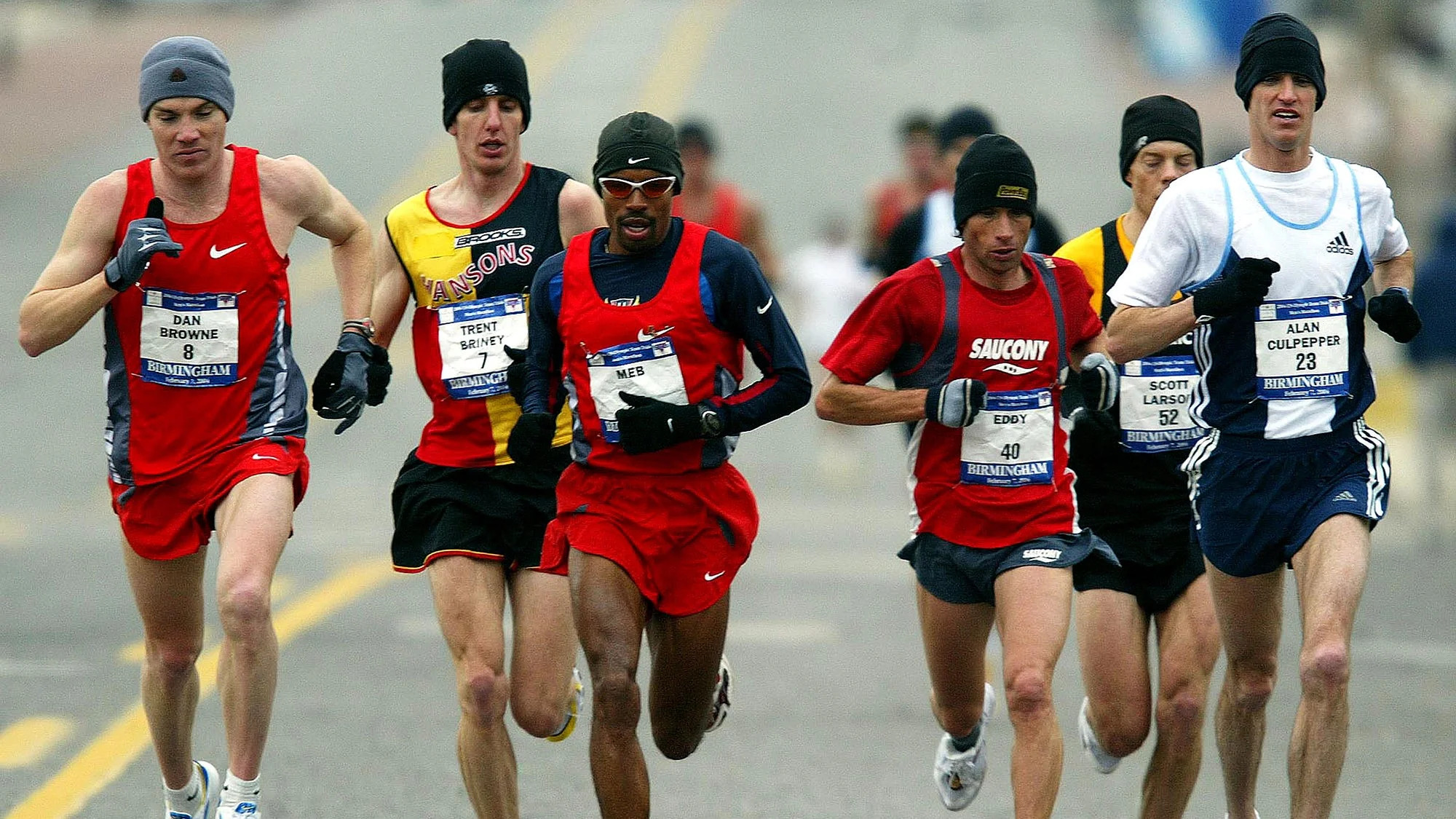

Featured
How To Train For Long Distance Running
Modified: January 22, 2024
Get expert advice on how to train for long distance running and reach your goals. Stay motivated and improve your performance with featured tips and techniques.
Introduction
Welcome to the exciting world of long distance running! Whether you’re a beginner looking to challenge yourself or a seasoned runner aiming for a marathon, training for long distance running requires dedication, discipline, and a well-rounded approach. With the right mindset and proper guidance, you can push your limits and achieve your goals.
Long distance running offers a plethora of physical and mental benefits. It improves cardiovascular health, strengthens muscles, boosts endurance, and even enhances mental stamina. However, embarking on this journey without proper preparation can lead to injuries and setbacks. That’s why it’s crucial to have a structured training plan and follow it diligently.
In this article, we will delve into the key aspects of training for long distance running. We will discuss goal-setting, building endurance, incorporating speed work, proper nutrition and hydration, rest and recovery, mental stamina, injury prevention, cross-training, and the essential gear you’ll need. By following these guidelines, you will be well-equipped to face the challenges and enjoy the rewards of long distance running.
Remember, long distance running is not just about physical fitness; it’s also about mental fortitude. It requires embracing the discomfort, surpassing self-imposed limits, and staying motivated along the way. Let’s dive into the details of each aspect of training to help you become a stronger and more accomplished long distance runner.
Setting Goals
Before embarking on your long distance running journey, it’s essential to set clear and achievable goals. Having a specific goal in mind will provide direction and motivation throughout your training. Whether it’s completing a certain distance, improving your race time, or participating in a marathon, defining your objectives will help you stay focused and committed.
Start by evaluating your current fitness level and consider any previous running experience. Be realistic when setting your goals, taking into account your physical capabilities and the time you can dedicate to training. It’s important to strike a balance between pushing yourself and avoiding injury or burnout.
When setting your goals, make sure they are specific, measurable, attainable, relevant, and time-bound (SMART). Avoid vague statements like “I want to run faster” or “I want to go farther.” Instead, set clear targets like “I want to complete a half marathon in under two hours within six months.
Break down your main goal into smaller milestones to help you stay motivated and track your progress. Celebrate each achievement along the way, whether it’s running your first 5K or shaving a few seconds off your personal best. These smaller victories will give you the confidence and momentum to keep pushing forward.
Additionally, consider creating a training schedule that outlines specific milestones and timelines leading up to your target race or distance. Having a plan in place not only keeps you accountable but also ensures that you give yourself enough time to gradually build up your endurance and avoid overexertion.
Remember that goals can evolve as you progress in your training. Don’t be afraid to adjust them if necessary, especially if you find yourself surpassing your initial expectations. Flexibility and adaptability are important when it comes to long distance running.
In setting your goals, it’s also crucial to focus on the process rather than just the outcome. Appreciate the small improvements you make, the consistency of your training, and the joy of pushing your limits, rather than solely fixating on the end result. Long distance running is a journey, and the fulfillment comes from the dedication and effort you put into it.
Building Endurance
Building endurance is a fundamental aspect of long distance running. It involves gradually increasing your cardiovascular capacity and stamina to sustain prolonged efforts. By improving your endurance, you’ll be able to run longer distances with greater ease and maintain a consistent pace throughout your training runs and races.
One of the most effective ways to build endurance is through consistent, progressive training. Start by incorporating regular runs into your routine, focusing on maintaining a comfortable pace that allows you to hold a conversation. Gradually increase the duration and distance of your runs over time, adding about 10% each week to avoid overexertion. This progressive overload helps your body adapt and grow stronger.
In addition to increasing the duration of your runs, it’s important to vary the intensity. Incorporate tempo runs, which involve running at a faster pace than your usual training pace, to challenge your cardiovascular system and improve your lactate threshold. Interval training, alternating between periods of high-intensity effort and recovery, is another effective way to boost endurance and speed.
Long, slow distance (LSD) runs are also crucial for building endurance. These runs are done at a relaxed pace and are longer than your usual training runs. LSD runs help train your body and mind to handle the demands of running over extended periods. They also allow you to practice fueling and hydration strategies for longer distances.
Strength training plays a vital role in building endurance as well. Engage in regular strength and resistance training exercises to strengthen your muscles, improve your running form, and prevent injury. Focus on exercises that target your lower body, including squats, lunges, and calf raises.
Consistency is key in building endurance. Aim to run at least three to four times per week, gradually increasing the duration and intensity of your runs. This will help your body adapt to the demands of long distance running and build the resilience needed to tackle the challenges that lie ahead.
Remember, building endurance takes time and patience. Don’t rush the process or get discouraged if progress seems slow. Stay consistent, listen to your body, and trust in the training plan you’ve set for yourself. In doing so, you’ll steadily improve your endurance and become a stronger long distance runner.
Incorporating Speed Work
While building endurance is essential for long distance running, incorporating speed work into your training regimen is equally important. Speed work helps improve your running economy, increases your anaerobic threshold, and enables you to maintain a faster pace during races.
One effective speed training technique is interval training. This involves alternating between periods of high-intensity effort and recovery. For example, you might sprint at maximum effort for 400 meters, then recover by jogging or walking for 200 meters before repeating the cycle several times. Interval training allows you to push your body to higher intensities, improving your anaerobic fitness and increasing your ability to sustain faster speeds.
Another speed training method is tempo runs. Tempo runs involve running at a comfortably hard pace, just below your maximum effort. These runs target your lactate threshold, the point at which lactic acid starts to accumulate in your muscles. By training at this intensity, you can increase your lactate threshold, allowing you to maintain a fast pace for longer periods.
Fartlek runs also offer a versatile approach to speed work. Fartlek, which means “speed play” in Swedish, involves alternating between periods of fast running and slower recovery or easy jogging. This type of training mimics the unpredictable nature of race conditions and helps you develop the ability to adjust your pace as needed.
When incorporating speed work into your training, it’s important to start gradually. Begin with shorter intervals or shorter tempo runs and gradually increase the intensity and duration as you build your fitness. Allow adequate recovery between speed sessions to avoid overtraining and reduce the risk of injury.
It’s also crucial to warm up properly before engaging in speed work. Perform dynamic stretches, such as leg swings or high knees, to prepare your muscles for the higher intensity. Cool down with a slow jog and static stretches to help prevent muscle soreness and aid in recovery.
Remember, speed work should be incorporated strategically within your training plan. Aim to include one to two speed sessions per week, with adequate rest days in between to allow your body to recover and adapt.
Incorporating speed work into your long distance running training can significantly enhance your overall performance. It allows you to increase your pace, improve your running efficiency, and challenge your body in new ways. By adding variety to your training regimen, you’ll become a well-rounded and formidable long distance runner.
Proper Nutrition and Hydration
Proper nutrition and hydration are vital components of long distance running. Fueling your body with the right nutrients and maintaining hydration levels can significantly impact your performance, endurance, and recovery. Here are some key guidelines to follow:
1. Balanced Diet: Consume a well-balanced diet consisting of carbohydrates, proteins, healthy fats, and a variety of fruits and vegetables. Carbohydrates provide the energy needed for long distance running, while proteins help repair and build muscle tissue. Healthy fats support hormone production and aid in nutrient absorption.
2. Pre-Run Nutrition: Eat a balanced meal containing complex carbohydrates, lean proteins, and some healthy fats about 2-3 hours before your run. This will provide a steady source of energy and prevent hunger during your run. Avoid heavy or high-fiber foods that may cause gastrointestinal distress.
3. During-Run Hydration and Fuel: Stay adequately hydrated throughout your run, especially for longer distances. Aim to drink water every 15-20 minutes or use sports drinks that provide electrolytes. Experiment with energy gels, chews, or bars to replenish carbohydrates and maintain energy levels during endurance runs.
4. Post-Run Recovery: Within 30 minutes of completing your run, consume a snack or meal rich in carbohydrates and protein to support muscle recovery and glycogen replenishment. Include a good source of lean protein, such as chicken or tofu, along with complex carbohydrates like quinoa or brown rice.
5. Hydration: Hydrate well throughout the day, not just during your runs. Aim to drink enough water to maintain clear urine and stay adequately hydrated. Monitor your urine color as a general guideline; pale yellow urine indicates proper hydration, while dark yellow or amber urine may indicate dehydration.
6. Electrolyte Balance: With long distance running comes the risk of electrolyte imbalances due to excessive sweating. Replenish electrolytes by consuming foods rich in potassium, sodium, magnesium, and calcium. Coconut water and sports drinks can also help restore electrolyte balance.
7. Individual Needs: Remember that everyone’s nutritional needs may vary. Experiment with different foods, hydration strategies, and timing to find what works best for you. Consider consulting a registered dietitian who specializes in sports nutrition to create a personalized nutrition plan.
8. Listen to Your Body: Pay attention to hunger cues and customize your nutrition and hydration based on your individual needs. Learn to differentiate between actual hunger and thirst signals to prevent overeating or underhydrating.
Proper nutrition and hydration significantly impact your running performance, recovery, and overall well-being. By fueling your body with nutritious foods and staying properly hydrated, you’ll have the energy and endurance to tackle long distance runs and reach your goals.
Rest and Recovery
Rest and recovery are often underestimated but play a crucial role in long distance running. Giving your body time to rest and recover is essential for preventing injuries, allowing your muscles to repair and rebuild, and optimizing your overall performance. Here are some key factors to consider when it comes to rest and recovery:
1. Adequate Sleep: Getting enough sleep is vital for recovery. Aim for 7-8 hours of quality sleep each night to allow your body to repair and recharge. Sleep helps regulate hormone levels, promotes muscle repair, and enhances mental well-being, which are all essential for long distance running.
2. Active Recovery: Engage in low-impact activities on your rest days, such as walking, swimming, or cycling. These activities help increase blood flow, flush out metabolic waste, and promote muscle recovery. Active recovery also helps prevent stiffness and promotes faster healing of minor running-related injuries.
3. Listen to Your Body: Pay attention to any signs of overtraining, such as persistent fatigue, decreased performance, or an increased risk of injury. Listen to your body’s signals and give yourself additional rest days or lower-intensity workouts as needed to avoid burnout.
4. Foam Rolling and Stretching: Incorporate foam rolling and stretching into your routine to relieve muscle tension and improve flexibility. Foam rolling helps break up adhesions and knots in the muscles, while stretching reduces muscle tightness and enhances range of motion. These practices can aid in recovery and prevent muscle imbalances.
5. Massage and Physical Therapy: Consider regular massage sessions or visits to a physical therapist to address any muscle imbalances, knots, or tightness. Massage therapy can help improve blood circulation, reduce muscle soreness, and enhance overall recovery and performance.
6. Hydrate and Refuel: Proper hydration and nutrition before and after runs are crucial for replenishing fluids, electrolytes, and energy stores. Refuel with a combination of carbohydrates and protein within 30 minutes after a run to support muscle recovery and glycogen replenishment. Drinking plenty of water throughout the day aids in maintaining hydration levels.
7. Mental Rest: Rest and recovery are not just physical; they also involve mental rest. Give yourself time to unwind, relax, and engage in activities that help reduce stress and promote mental well-being. This could include practicing mindfulness, spending time with loved ones, or enjoying hobbies outside of running.
8. Gradual Progression: Avoid increasing your mileage or intensity too quickly. Gradual progression allows your body to adapt and recover between runs. Follow the 10% rule, which recommends increasing weekly mileage by no more than 10%, to minimize the risk of overuse injuries.
Remember, rest and recovery are just as important as training when it comes to long distance running. By prioritizing adequate sleep, incorporating active recovery, listening to your body, and taking care of both your physical and mental well-being, you’ll enhance your running performance and reduce the risk of injury.
Mental Stamina
Building mental stamina is essential for long distance running. Running extended distances requires not only physical strength but also mental fortitude to overcome challenges and push through the inevitable moments of doubt and fatigue. Here are some strategies to develop and enhance your mental stamina:
1. Set Clear Goals: Having clear and achievable goals provides focus and motivation during training and races. Visualize yourself crossing the finish line or achieving your desired time, and remind yourself of your goals during challenging moments to stay motivated and push through.
2. Positive Self-Talk: Use positive affirmations and self-talk to reinforce a positive mindset. Replace negative thoughts with encouraging phrases such as “I am strong” or “I can do this.” Adopting a positive attitude can help overcome mental barriers and keep you going during tough times.
3. Break It Down: When faced with a long distance run, break it down into smaller segments. Focus on one mile or one kilometer at a time, rather than overwhelming yourself with the entire distance. Celebrate small achievements along the way to boost your confidence and maintain motivation.
4. Practice Visualization: Visualize successful runs and races beforehand. Imagine yourself smoothly gliding through the course, feeling strong and confident. Visualizing positive outcomes can reduce anxiety and mentally prepare you for the challenges ahead.
5. Learn from Setbacks: Setbacks and challenges are a part of long distance running. Instead of dwelling on them, view them as opportunities for growth and learning. Embrace the lessons they offer and use them to become an even stronger and more resilient runner.
6. Breakthrough Workouts: Include specific workouts in your training to simulate race conditions and push beyond your comfort zone. These breakthrough workouts help build mental and physical resilience and instill confidence in your ability to endure challenging situations.
7. Mind-Body Connection: Develop a strong mind-body connection by practicing mindfulness or meditation. Being present in the moment and focused on your body’s sensations can help you stay centered and push through mental fatigue or distractions.
8. Find Inspiration: Seek inspiration from others who have overcome similar challenges or achieved remarkable feats in long distance running. Surround yourself with a supportive community of fellow runners and engage in conversations or read books and articles that motivate and inspire you.
9. Embrace Discomfort: Long distance running is not always comfortable, and embracing this discomfort is an important part of building mental stamina. Embrace the physical and mental challenges, knowing that they are opportunities to grow and become a stronger runner.
Remember, mental stamina is not developed overnight. It requires consistent practice and a positive mindset. By incorporating these strategies into your training and races, you can cultivate mental fortitude and unlock your full potential as a long distance runner.
Injury Prevention
Preventing injuries is crucial for long distance runners. A single injury can disrupt your training and hinder your progress. To stay healthy and avoid setbacks, incorporate the following strategies into your training regimen:
1. Gradual Progression: Avoid sudden increases in mileage or intensity. Gradually increase your training load to give your body time to adapt and reduce the risk of overuse injuries. Follow a structured training plan that includes rest days and easy runs to allow for recovery.
2. Strength Training: Incorporate strength training exercises to strengthen the muscles, tendons, and ligaments that support your running. Focus on lower body exercises such as squats, lunges, and calf raises, as well as exercises to target core stability and upper body strength. Strong muscles and a stable core can help prevent imbalances and reduce the risk of injury.
3. Proper Form and Technique: Maintain good running form to reduce the strain on your muscles and joints. Keep your posture upright, relax your shoulders, and land with a midfoot strike. Avoid overstriding and excessive heel striking, as these can lead to increased impact forces and potential injuries.
4. Rest and Recovery: Allow for adequate rest and recovery between runs. This allows time for your body to repair and rebuild, reducing the risk of overuse injuries. Listen to your body and take additional rest days when needed.
5. Cross-Training: Incorporate cross-training activities such as cycling, swimming, or yoga into your routine. This helps strengthen different muscle groups, provides variety to your training, and reduces the risk of overuse injuries from repetitive running motions.
6. Proper Footwear: Wearing the right shoes that provide proper support and cushioning for your foot type and gait can significantly reduce the risk of injuries. Visit a specialty running store for a gait analysis and professional advice to find the right pair of shoes for your needs.
7. Warm-Up and Cool-Down: Always warm up before your runs, engaging in dynamic stretches and mobility exercises to increase blood flow and prepare your muscles for activity. Similarly, cool down with static stretching and gentle exercises to promote circulation and aid in recovery.
8. Listen to Your Body: Pay attention to any warning signs of pain, discomfort, or abnormalities in your body. If something doesn’t feel right, don’t ignore it. Address issues promptly by seeking advice from a healthcare professional to prevent minor issues from developing into more serious injuries.
9. Proper Nutrition and Hydration: Maintain a well-balanced diet and stay hydrated to support the health of your muscles, tendons, and bones. Proper nutrition and hydration can enhance recovery and reduce the risk of fatigue and injuries.
By implementing these injury prevention strategies, you can keep yourself on track and minimize the risk of injuries that could hinder your progress as a long distance runner. Prioritize your health and take the necessary steps to ensure a safe and successful running journey.
Cross Training
Cross training refers to incorporating different types of exercises and activities into your training regimen alongside running. Engaging in cross training is beneficial for long distance runners as it helps improve overall fitness, prevents overuse injuries, and provides variety to your training routine. Here are some key benefits and examples of cross training:
1. Balanced Fitness: Cross training allows you to work different muscle groups and improve overall strength, flexibility, and cardiovascular fitness. It helps to address any muscle imbalances that may arise from repetitive running motions, making you a more well-rounded athlete.
2. Injury Prevention: By engaging in activities that have lower impact on your joints, cross training reduces the risk of overuse injuries. It allows your body to recover and adapt while still maintaining cardiovascular fitness. Cycling, swimming, and elliptical training are excellent low-impact options.
3. Active Recovery: Cross training can be used as active recovery on rest days or lighter training days. Engaging in low-intensity activities like yoga, Pilates, or gentle stretching can help improve flexibility, reduce muscle soreness, and promote relaxation.
4. Cardiovascular Conditioning: Participating in aerobic exercises such as swimming, cycling, or rowing can enhance your cardiovascular endurance without subjecting your body to the repetitive impact of running. This can improve your overall aerobic capacity, benefiting your running performance.
5. Strength and Core Training: Incorporate strength training exercises to target muscles that may not be solely engaged during running. Focus on exercises such as lunges, squats, planks, and push-ups to strengthen your core, legs, and upper body, which can improve running form and efficiency.
6. Flexibility and Mobility: Activities like yoga and Pilates help improve flexibility, range of motion, and body awareness. This can enhance your running technique and prevent injuries resulting from tight muscles and limited mobility.
7. Mental Refreshment: Cross training provides a break from the repetitive nature of running. It offers a chance to engage in different activities that you enjoy and can rejuvenate your mental focus on running when you return to it.
8. Rehabilitation and Injury Recovery: Cross training can be used as part of a rehabilitation program when recovering from an injury. Consult with a healthcare professional or physical therapist to determine which activities are appropriate for your specific condition.
When incorporating cross training into your routine, it’s important to strike a balance that complements your running training. Aim to cross train 1-2 days per week, depending on your individual needs and training volume. Vary the activities you choose and select ones that you enjoy to maintain motivation and prevent boredom.
Remember, cross training should enhance your running, not detract from it. Listen to your body and adjust your cross training activities as needed to support your running goals. By incorporating cross training into your routine, you’ll become a stronger, more well-rounded runner and reduce the risk of overuse injuries.
Long Distance Running Gear
When it comes to long distance running, having the right gear can make a significant difference in your comfort, performance, and overall running experience. Here are some essential items of long distance running gear to consider:
1. Running Shoes: Invest in a pair of well-fitting running shoes that provide proper support and cushioning for your foot type and running gait. Visit a specialty running store for a gait analysis and professional advice to choose the right shoes that suit your needs and reduce the risk of foot and leg injuries.
2. Moisture-Wicking Clothing: Opt for moisture-wicking clothing made of breathable fabrics that help draw sweat away from your skin, keeping you dry and comfortable during long runs. Choose clothes suitable for the weather conditions, considering factors like temperature, humidity, and wind.
3. Running Shorts or Tights: Select running shorts or tights that provide a comfortable fit and allow for freedom of movement. Look for options with built-in or separate compression shorts for added support.
4. Performance Socks: Invest in high-quality moisture-wicking socks to keep your feet dry and prevent blisters. Look for socks with cushioning in key areas and seamless construction for added comfort.
5. Sports Bra: Female runners should invest in a supportive and comfortable sports bra that provides adequate support during long distance runs. Look for options with moisture-wicking fabric and adjustable straps for a personalized fit.
6. GPS Watch: A GPS watch can be a valuable tool for long distance runners, allowing you to track your distance, pace, and other important metrics. Look for a watch with a long battery life, accurate GPS tracking, and additional features such as heart rate monitoring.
7. Hydration Belt or Vest: For longer distance runs, a hydration belt or vest can come in handy. These accessories provide convenient storage for water bottles or hydration bladders, allowing you to stay hydrated without interrupting your run.
8. Hat or Visor: Protect yourself from the sun’s rays and keep sweat away from your eyes with a lightweight hat or visor. Look for options with breathable materials and a moisture-wicking liner.
9. Sunglasses: Choose sunglasses with UV protection to shield your eyes from the sun’s harmful rays. Look for options with non-slip frames and lenses that provide clarity and reduce glare.
10. Reflective Gear: If you plan to run in low-light conditions or at night, wear reflective gear to ensure visibility and safety. This can include reflective vests, bands, or light-up accessories.
Remember to test out your gear during shorter runs or training sessions to ensure everything fits well and is comfortable. Avoid trying new gear on race day to prevent any discomfort or surprises.
Investing in the right gear and equipment for long distance running can greatly impact your running experience. Properly fitted shoes, moisture-wicking clothing, and accessories that enhance your comfort and safety will contribute to your overall enjoyment and help you perform your best during those lengthy runs.
Conclusion
Training for long distance running is a rewarding and transformative journey. By setting clear goals, building endurance, incorporating speed work, fueling your body properly, prioritizing rest and recovery, strengthening your mental stamina, taking steps to prevent injuries, and using the right gear, you can unlock your full potential as a long distance runner.
Remember that long distance running is not just about physical fitness; it also requires mental resilience, determination, and discipline. Embrace the challenges, listen to your body, and stay motivated along the way. Celebrate your achievements, no matter how small, and learn from setbacks to continuously improve and grow as a runner.
Additionally, always prioritize your health and safety. Pay attention to your body’s signals, seek professional advice when needed, and take steps to prevent injuries through proper training, rest, and recovery. Remember that a well-rounded approach to training and self-care is essential for long term success and enjoyment in long distance running.
Lastly, have fun! Long distance running is a journey that offers physical, mental, and emotional growth. Enjoy the process, embrace the friendships and camaraderie that come with it, and revel in the thrill of crossing the finish line and achieving your goals.
So lace up your shoes, commit to your training plan, and embark on your long distance running adventure with confidence. With dedication, perseverance, and a positive mindset, you can accomplish remarkable feats and discover the true power within yourself.









